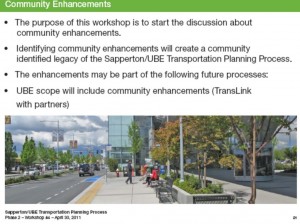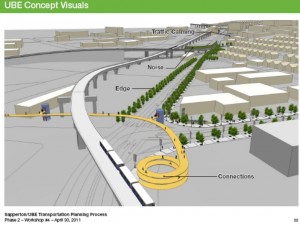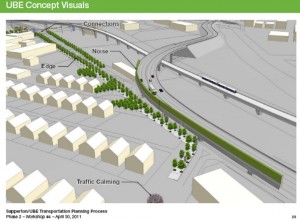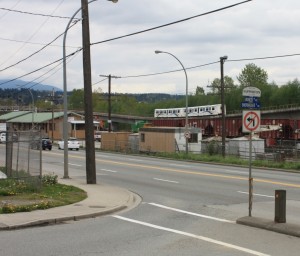Now that the “Community Concepts” have been developed, TransLink is emphasizing the “Community Enhancements”. Which sound much better than “mitigation”. The latter is about trying to reduce the inevitable negative impacts (and is, of sorts, an admission that there will be negative impacts that require mitigation), the former sounds like the cherry on top of an ice cream sundae. Too bad I’m lactose intolerant.
 |
| click to make big |
It didn’t build my confidence when the slide they showed to demonstrate model enhancement is an image of a Canada Line station and No. 3 Road in Richmond. As someone who rides a bike through Richmond on a regular basis, I’m not afraid to say the No 3 Road bike route shown in the image is a disaster. It is partly a raised and painted separated bike route, except for all the commercial driveways crossing it that are almost all blind due to the location of the support towers for the overhead SkyTrain line. Once or twice a block, the painted route becomes a bus stop (see the image). Then right at the station, the bike route becomes the favoured pedestrian route around the station itself. So the Canada Line Bike Route is a recipe conflict between bikes and cars, bikes and busses, bikes and pedestrians. A waste of money that doesn’t serve the community it is built for. Let’s hope we don’t end up with the same thing here.
So let’s look at some of the baubles we are being offered.
This leaf-spring overpass plan seemed to be a major part of the discussions. With the level rail crossing at Braid closed, an alternative plan for getting people not in cars across the tracks is required. The challenge is making a structure suitable for pedestrians, cyclists, and people with mobility issues. Stairs are reliable, elevators are accessible. Long ramps wrapped into loops are both, but make for a large structure and turn crossing the street into a 2-kilometre journey.
To me, this is the ultimate expression of a “bauble”. We are trying to have a discussion about the implications of doubling the traffic entering New Westminster from the East, and TransLink engages us in a long discussion about what flavour of pedestrian overpass we want. No wonder the crowd was getting restless. This kind of design element can be discusses long after there has been a decision to build or not to build. At best, it is a waste of engineering time, at worst, it is a distraction from the real story.
I do note that all of the “enhancement” images showed “Concept B1”. This led more credence to the theory that TransLink has already decided which option they will be taking forward.
There was also much discussion of “edge” concepts. No surprises here, everyone thought trees and planters were better than… um… no trees or planters (again, why are we talking about this now?). Absent from the drawings were the 75 kV power lines that run along the west side of Brunette, and the communications lines that run along the east side: those trees are either going to be very short (10 feet is the safe approach limit from BC Hydro), or the lines will need to be moved (not a minor task).
Anyway, good to know that replacing roadways with green space, or at least separating people from roads with green space, is about the only thing that received unanimous support…Maybe we can all agree on something.
Now let’s talk about the wall. One of the early concerns from the Sapperton Neighbourhood (other than the knocking down of their houses) was the impact on the neighbourhood of an elevated truck highway in front of their homes. To manage this concern, TransLink is offering a noise wall, even suggesting that it can be a “green wall”, with vertical plantings to make it more attractive.
I have nothing against a Green Wall per se, but the high angle view shown above doesn’t give a very good impression of how high the wall would have to be to provide adequate noise abatement to not just the properties on Rosseau, but those up on Wilson, or Garrett. (Here is a bit of a primer on vehicle noise from some specialists in the field). Much of the noise of these trucks is produces at the exhaust, 2 or 3 metres above the road, and Sapperton slopes up from t his road, creating line-of-sight challenges the further up the hill you go. I’m not saying an effective wall cannot be built, but the visual effect of the wall, on top of the height required for the overpass to clear the rails and the SkyTrain at the Dip, is starting to add up to a pretty big wall.
Just for perspective, here is a photo of the Skytrain swooping through the “Dip”. The white Sky Train Mark I train is about 2.5 m high from the top of the wheels to the roof. So picture another 2.5 m or so for the overpass structure, then another 3m or so for a Green wall.
Personally, I’m hoping we can take a closer look at Option “E”, and the long-dismissed Option “C”. I guess we will know on Thursday.



As someone who walks and rides for most of my trips in New Westminster, I’ve really been put off by TransLink’s focus on ped/bike facilities for the UBE project.
Currently the state of pedestrian/cycling facilities in the City of Coquitlam are completely unacceptable so the UBE ped/bike proposals are akin to “bridges to no where”.
But worse is that the building of the UBE will flood New West City streets with more cars (as our current major road network cannot handle any more and there are no serious plans to address these issues). This will negatively impact the safety and comfort of those already walking and cycling throughout New Westminster. (and a large number of residents walk on City streets, and a growing number are cycling)
So to get some spiffy ped/cycling facilities that few people will ever use (until Coquitlam redoes 40 years of poor road building practices) a very walkable-cyclable City will be downgraded on the livability scale.
Not a usual blog poster I make this exception since for the most part P@J takes the heat from unknown posts not the writers – LOL
You may want to note the Newsleader article May 13 Page A15. Translink is cutting cycling network support from $6 million to $3 million. I suspect this will have a negative effect on expansion in the area of bike infrastructure.
James Crosty
Thanks for that catch James. Just more proof TransLink is a rudderless ship right now. They have abandoned their own 2040 planning principles less than two years after they were established.
New West has one of the highest rates of transit use in the Province, and they reward us by taking away bus service then offering us a highway. If there is more than my usual cynicism bleeding through, you can see why.
Ya well buckle up. The city just moved one step closer to approving an incinerator…..with more trucks delivering and departing. What will translink tell us now?
JC